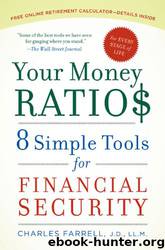Your Money Ratios by Farrell J.D. LL.M. Charles

Author:Farrell, J.D., LL.M., Charles
Language: eng
Format: epub
Publisher: PENGUIN group
Having a Plan B
I have mentioned that, over the long term, the stock market has returned about 9.5% per year and U.S. Treasury bonds about 5.5%. It is important to take a closer look at these return figures so that you have a better sense of what you might experience in the financial markets.
Although stocks have averaged about 9.5%, they have gotten there via the scenic route. In fact, if we look at the stock market returns over the last 100 years, rarely does the stock market have an annual return within 1% of the 9.5% long-term average.
Let me give you a simple example of what this means. Suppose you have two bricks: one that weighs 10 pounds and one that weighs 30 pounds. When you add the two together, you get 40 pounds worth of bricks. Since we have two bricks, the average brick weighs 20 pounds. But, neither brick actually weighs 20 pounds. This is the problem with averages. When there is a big difference in the size of things we are measuring, averages can be misleading.
This is similar to the stock market. There are big differences among the returns in any given year, which makes the average number somewhat misleading. While the average return is 9.5%, we don’t have many years that actually return 9.5%, or even close to that. We usually get a +20%, -10%, etc., and when you average them all out, it gives us an annualized number of 9.5% over about 100 years. But that average number doesn’t tell you much about what you can expect in any given year or shorter-term cycle.
For instance, the best calendar year in the stock market was a +54% and the worst was a -44%. Those numbers aren’t anywhere near the 9.5% average. Moreover, the best 10-year period was a +20% and the worst was about a -1.4%.
By the way, the best 10-year period was in the 1950s; the worst 10-year period ended in 2008.
The same is true with 20-year periods. The best 20-year period was a +17% (1980 to 1999) and the worst was a +3% (1929 to 1948). Although both cycles were positive, they are well above and well below the average of 9.5%. This is about as much as you can say about risks in the stock market. It doesn’t lend itself to any more precision. You just never know what you might experience, but the good years generally far outweigh the bad years over longer-term cycles. If you are prudent about how you take your risks, then investing in stocks may well be worth it to help you meet your long-term wealth accumulation goals.
What history shows us is that stock returns tend to cluster in really good cycles and really bad cycles. It is important to have the proper mind-set so that you can rationally cope with the volatility and put into place a portfolio strategy that helps you benefit from the good years but protects you in the bad. If you expect the
Download
This site does not store any files on its server. We only index and link to content provided by other sites. Please contact the content providers to delete copyright contents if any and email us, we'll remove relevant links or contents immediately.
The Compound Effect by Darren Hardy(8523)
Tools of Titans by Timothy Ferriss(7823)
Nudge - Improving Decisions about Health, Wealth, and Happiness by Thaler Sunstein(7255)
Win Bigly by Scott Adams(6831)
Deep Work by Cal Newport(6574)
Rich Dad Poor Dad by Robert T. Kiyosaki(6185)
Pioneering Portfolio Management by David F. Swensen(6083)
Principles: Life and Work by Ray Dalio(5980)
The Barefoot Investor by Scott Pape(5596)
Digital Minimalism by Cal Newport;(5396)
Grit by Angela Duckworth(5302)
The Slight Edge by Jeff Olson(5202)
Discipline Equals Freedom by Jocko Willink(5159)
The Motivation Myth by Jeff Haden(5008)
You Are a Badass at Making Money by Jen Sincero(4658)
The Four Tendencies by Gretchen Rubin(4427)
Eat That Frog! by Brian Tracy(4163)
The Confidence Code by Katty Kay(4041)
Bullshit Jobs by David Graeber(3837)
